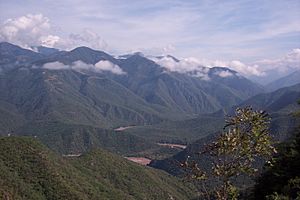Mexicana de Aviación Flight 940 facts for kids

A Mexicana Boeing 727, similar to the one involved
|
|
| Accident summary | |
|---|---|
| Date | March 31, 1986 |
| Summary | In-flight fire due to maintenance error, leading to loss of hydraulic and electrical systems. |
| Place | Michoacán, Mexico 19°50′05.2″N 100°18′27.3″W / 19.834778°N 100.307583°W |
| Passengers | 159 |
| Crew | 8 |
| Fatalities | 167 |
| Survivors | 0 |
| Aircraft type | Boeing 727-264 |
| Aircraft name | Veracruz |
| Airline/user | Mexicana de Aviacion |
| Registration | XA-MEM |
| Flew from | Benito Juárez International Airport |
| 1st stopover | Lic. Gustavo Díaz Ordaz International Airport |
| Last stopover | General Rafael Buelna International Airport |
| Flying to | Los Angeles International Airport |
Mexicana de Aviación Flight 940 was a flight operated by Mexicana de Aviación. On March 31, 1986, this plane was on a planned trip from Mexico City to Los Angeles. It had stops scheduled in Puerto Vallarta and Mazatlán. The aircraft, a Boeing 727-200 named "Veracruz" (registration XA-MEM), crashed into a mountain called El Carbón. This mountain is located in the Sierra Madre Occidental range, northwest of Mexico City. Sadly, all 167 people on board died in the accident. This crash is the deadliest aviation disaster ever in Mexico. It is also the deadliest accident involving a Boeing 727 aircraft worldwide.
About the Flight
The airplane involved in the accident was delivered to Mexicana airlines in 1981. It was given the name "Veracruz." The pilot was Captain Carlos Guadarrama Sistos, who had flown for over 15,000 hours. The co-pilot was Philip L. Piaget Rhorer, and the flight engineer was Ángel Carlos Peñasco Espinoza. There were eight crew members in total, including five flight attendants.
At 8:50 AM local time, the plane took off from Benito Juárez International Airport in Mexico City. Its final destination was Los Angeles International Airport. The flight had planned stops in Puerto Vallarta and Mazatlán. There were 159 passengers and 8 crew members on board, making a total of 167 people.
The Crash
About fifteen minutes after the plane took off, at 9:05 AM, a loud explosion shook the aircraft. The pilot, Captain Guadarrama, and his crew quickly realized the plane was shaking badly. They immediately declared an emergency. They asked to return to Benito Juárez International Airport for an emergency landing. The airport ground crew prepared for the plane's urgent return.
However, the aircraft did not make it back. It crashed into El Carbón mountain, which is near the town of Maravatío, in Michoacán. The plane broke into two pieces and caught fire upon impact. All 167 people on board died instantly. Local police and the Mexican army were sent to the crash site right away. People who saw the crash told authorities what they had witnessed.
The Investigation
After the crash, two terrorist groups from the Middle East at first said they were responsible. They also claimed responsibility for another plane bombing that happened just two days later. However, investigators found this was not true.
The accident was investigated by the U.S. National Transportation Safety Board (NTSB) and Mexican aviation authorities. They discovered the real cause of the crash. A tire on the left main landing gear had been filled with regular compressed air instead of nitrogen. Airplane tires are usually filled with nitrogen because it is safer and does not expand as much with heat.
Investigators also found that this tire had signs of being very hot. This overheating was caused by a brake on the landing gear that was not working correctly. The combination of the wrong gas in the tire and the faulty brake led to the disaster.
What Happened Next
Mexicana airline's maintenance workers were found responsible for the accident. They were blamed for not properly taking care of the Boeing 727. They had made a mistake by filling the tire with compressed air instead of nitrogen.
About a year after the crash, the U.S. Federal Aviation Administration (FAA) issued a new rule. This rule required that only dry nitrogen or other safe, non-reactive gases be used to fill the tires on the wheels of most commercial airplanes.
Mexicana Flight 940 remains the deadliest airline disaster in Mexico's history. It is also the deadliest air accident involving a Boeing 727 aircraft anywhere in the world. Experts believe that the exploding tire caused fuel lines to break, leading to the fire that destroyed the plane in mid-air.
See also
 In Spanish: Vuelo 940 de Mexicana de Aviación para niños
In Spanish: Vuelo 940 de Mexicana de Aviación para niños
- Nigeria Airways Flight 2120 - A similar crash where under-inflated tires overheated and started a fire onboard. This fire damaged important control systems.
- Air France Flight 4590 - A 2000 Concorde crash caused by a tire bursting during takeoff, which then started a fire.
- Swissair Flight 306 - A 1963 crash caused by a fire during takeoff, which was started by a landing gear problem.
- ValuJet Flight 592 - A 1996 crash caused by a fire that started in the cargo area of the plane.
- Propair Flight 420 - Another aircraft where a fire began in the left wheel well of a Fairchild Metroliner.


